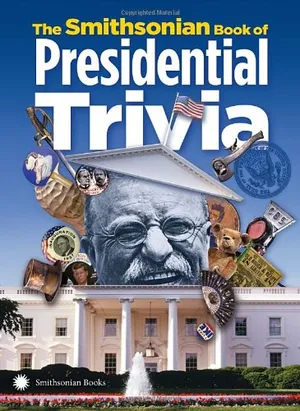Ten Fascinating Presidential Facts to Impress on Presidents’ Day
Learn a new side of the Commanders-in-Chief, from whiskey seances and magazine cover boys
/https://tf-cmsv2-smithsonianmag-media.s3.amazonaws.com/filer/2c/b4/2cb435c5-82d8-4926-bf51-2d3e821b19cc/ih175166.jpg)
Think you’ve got a firm handle on the presidents? The Smithsonian Book of Presidential Trivia from Smithsonian Books just might make you question how comprehensive your head-of-state knowledge actually is. To commemorate the Presidents' Day holiday, we offer some nuggets excerpted from the book that reveal a few unexpected facts about the sartorial habits, social practices and defining characteristics of our commanders-in-chief.
1. George Washington owned a profitable whiskey distillery.
Whiskey was one of Washington’s most important business ventures at Mount Vernon. At peak production in 1799, the distillery used five stills and a boiler and produced eleven thousand gallons of whiskey. With sales of $7,500 that year, it was perhaps the country’s largest distillery.
Washington’s plantation manager James Anderson, a Scottish man with distilling experience, urged him to start the venture, which was also an efficient way to use unsold ground wheat, corn and rye.
2. James Madison held the first Inaugural Ball.
Although there was a ball in 1789 to honor the election of George Washington, the first official inaugural ball did not occur until 1809, when Madison took office. Madison was sworn in at the U.S. Capitol.
That evening his wife, Dolley Madison, hosted a gala at Long’s Hotel. The price of admissions was four dollars per ticket. Four hundred tickets were sold, and so began a Washington tradition. Today the Presidential Inaugural Committee plans all the official inaugural balls.
3. Gerald Ford was a fashion model in his youth (even appearing on the cover of Cosmopolitan).
Ford’s first love was a woman named Phyllis Brown, a gorgeous blonde who became a fashion model. Brown persuaded Ford to invest in a modeling agency and to do some modeling himself.
Together they appeared in ski resort spread of Look magazine (1940) and on a cover of Cosmopolitan (1942). Ultimately, the pair broke up. She wanted to continue modeling in New York and he decided to forego the runway and begin his law career.
4. Warren Harding had the largest shoe size.
Harding wore a size 14. Unfortunately, those big feet did not ensure that his administration would be on firm footing. It turned out that Harding’s trusted advisors were not so trustworthy, and his presidency was riddled with scandal.
He died before his term was complete, and his wife burned his potentially incriminating correspondence. However, his stately slippers and sporty golf shoes survive at the Smithsonian.
5. Four presidents have received the Nobel Peace Prize including Theodore Roosevelt, Woodrow Wilson, Jimmy Carter and Barack Obama.
Roosevelt received his in 1906 for his many efforts toward international peace, including his role in formulating the 1905 peace treaty between Russia and Japan. Wilson was awarded the Nobel in 1919 for founding the League of Nations after World War I.
Carter was long retired from the presidency when he won the prize in 2002 for his efforts to advance human rights and advance peaceful solutions to international conflicts. Obama was honored with a Nobel in 2009 for his work toward strengthening international diplomacy and cooperation.
6. William Howard Taft became a Supreme Court Justice after his retirement.
A graduate of Yale and Cincinnati Law School, Taft loved law but was unsure about politics. At the urging of his wife, Nellie, and mentor, Theodore Roosevelt, he reluctantly accepted his party’s nomination for the presidency, calling the presidential campaign “one of the most uncomfortable four months of my life.”
After losing the 1912 election to Woodrow Wilson, Taft served as a professor of law at Yale and was later appointed by Warren Harding as chief justice of the United States, a pose he considered his greatest honor.
7. Theodore Roosevelt wore a lock of Lincoln’s hair during his inauguration.
Roosevelt wore a ring with a lock of Lincoln’s hair in it on March 14, 1905, at his second inauguration. Roosevelt had been a long-time admirer of Lincoln, and as a child had watched Lincoln’s funeral procession pass by his house in New York.
Roosevelt’s admiration for Lincoln was reinforced later, when he met John Hay, who had worked for Lincoln in the White House. Hay and Roosevelt talked about Lincoln often, and Hay gave Roosevelt the ring, knowing that Roosevelt would treasure it.
8. Franklin D. Roosevelt was the first president to name a woman to his cabinet.
FDR named Frances Perkins as secretary of labor in 1933. The Mount Holyoke College graduate was a trained social worker who had worked in settlement houses in Chicago and Philadelphia. Her efforts on behalf of labor reform took on an added urgency after the tragic Triangle Shirtwaist Factory fire in 1911.
She served as industrial commissioner under Roosevelt when he was governor of New York. As labor secretary, Perkins established the Labor Standards Bureau and was a principal architect of the Social Security Act.
9. John Tyler had 15 children.
Tyler was married twice. He had eight children with his first wife, Letitia. After she died, the 54-year-old president married the 24-year-old Julia Gardiner, with whom he had seven more children.
Tyler wins the prize for being the most prolific of all American presidents.
10. Abraham Lincoln attended séances at the White House.
Lincoln’s wife, Mary Lincoln, became interested in séances after their young son Willie died in 1862. At the White House, she engaged mediums, who conducted “spirit circles” or ceremonies during which those who attended could communicate with their loved ones who had crossed over into the next world.
Mary was eager to believe in these mediums as it made her loss somewhat bearable, and she encouraged the president to attend a few séances, which he did. It is not clear if Lincoln participated to appease his wife or out of real interest and belief.
/https://tf-cmsv2-smithsonianmag-media.s3.amazonaws.com/accounts/headshot/profile.jpg)

/https://tf-cmsv2-smithsonianmag-media.s3.amazonaws.com/accounts/headshot/profile.jpg)